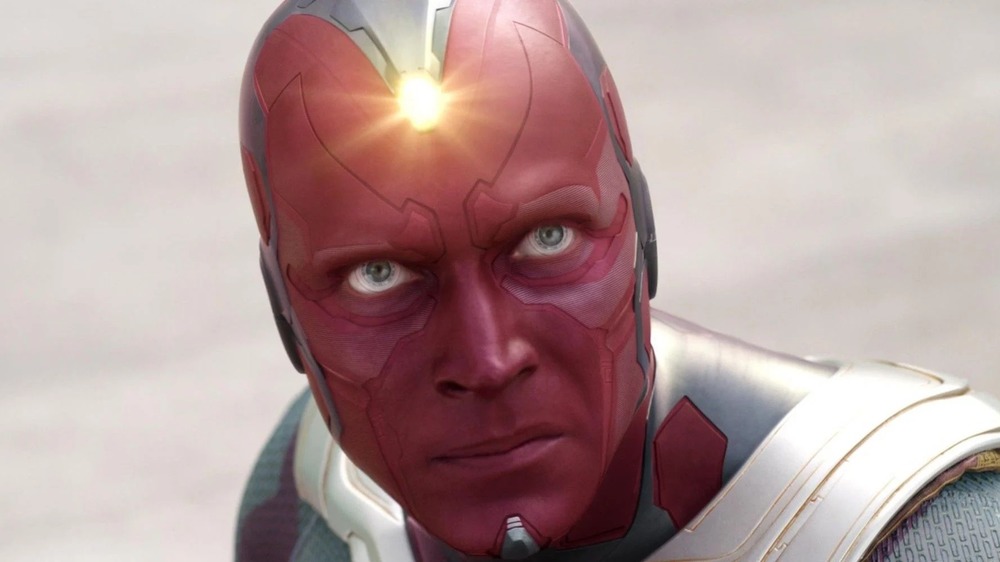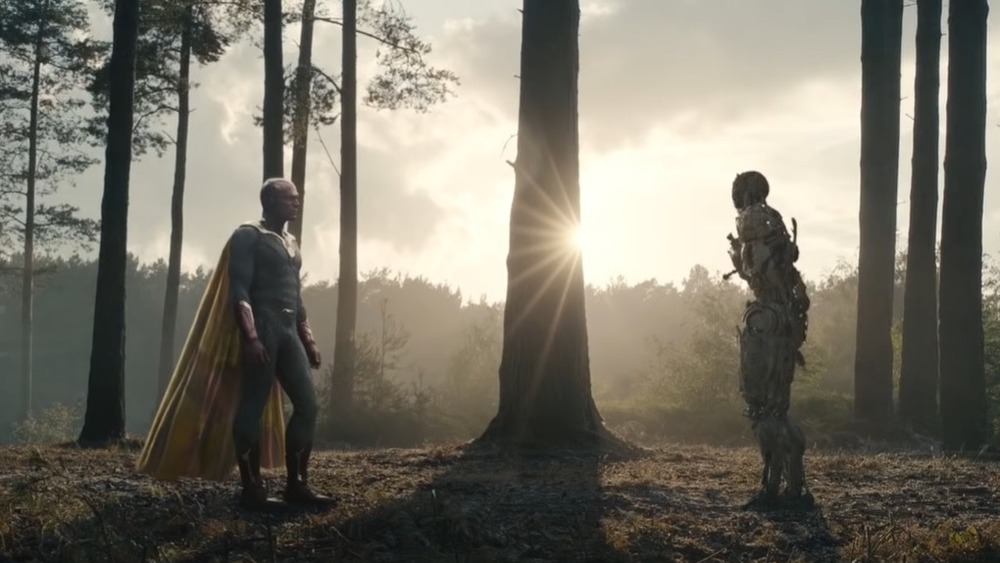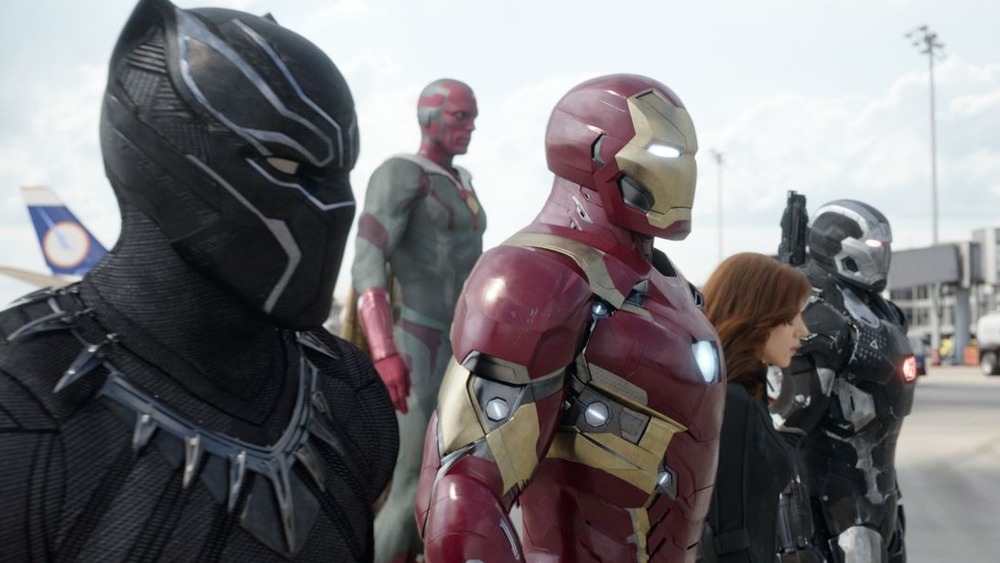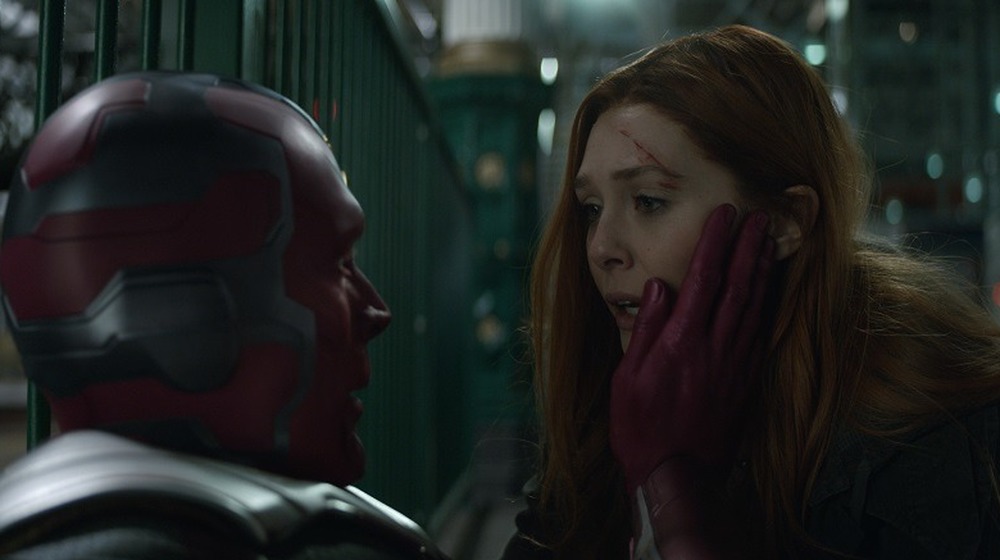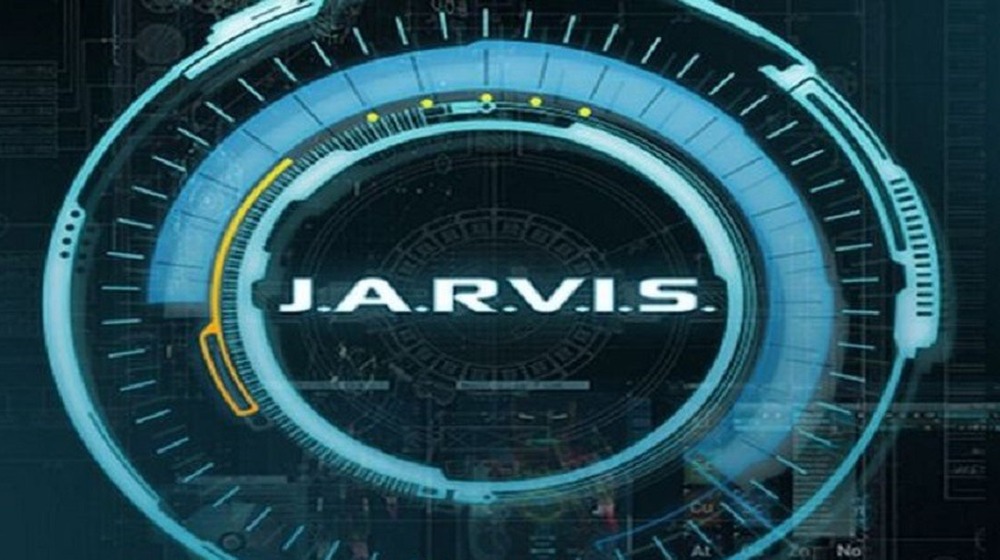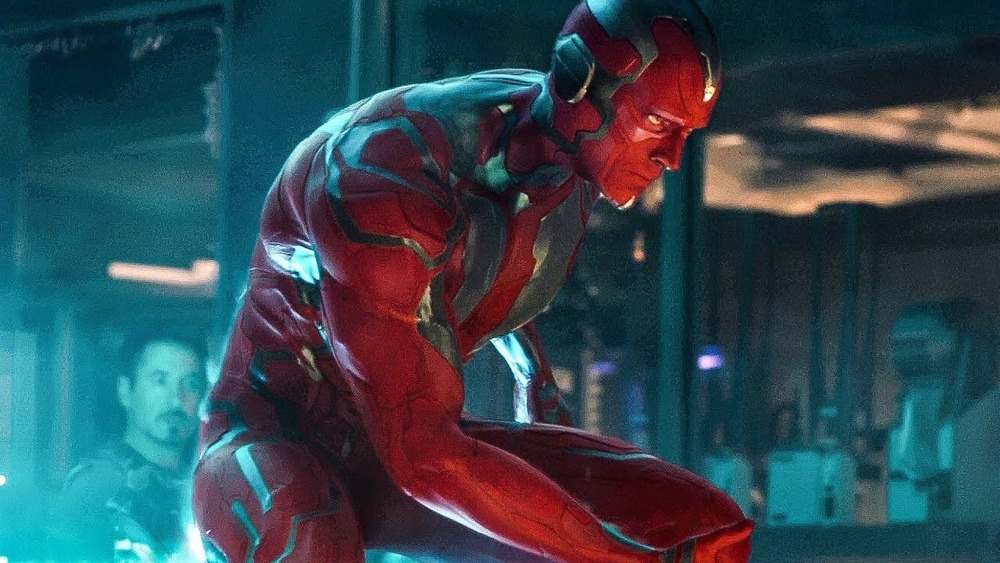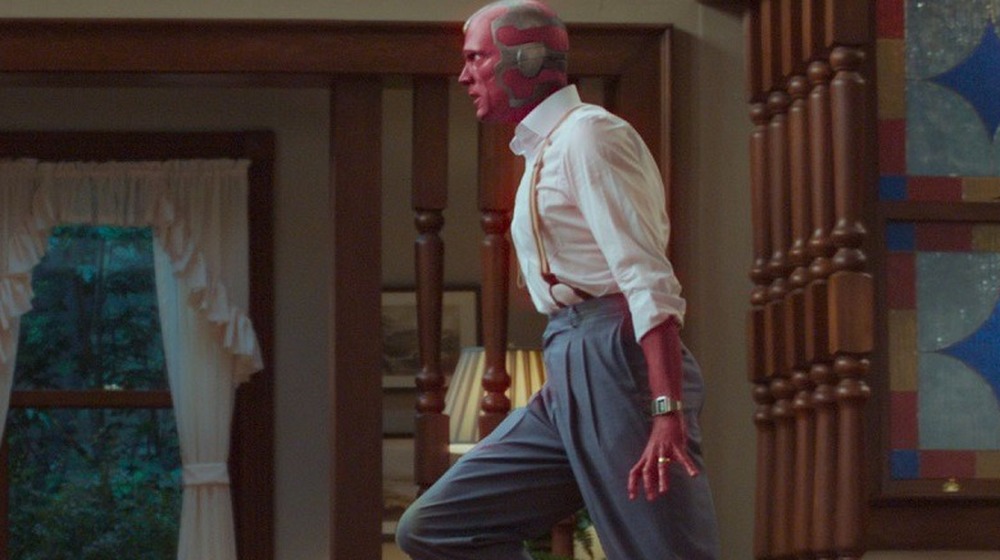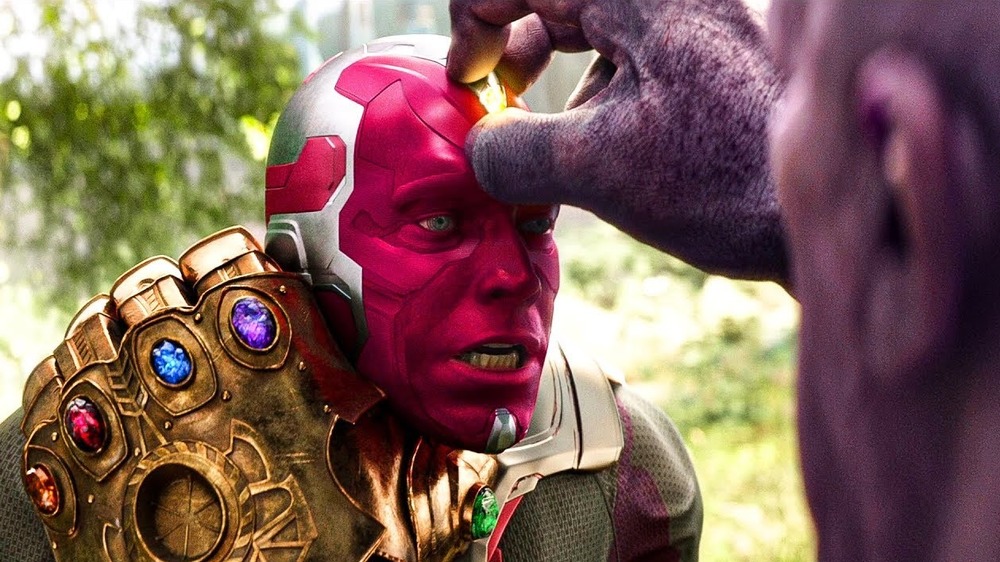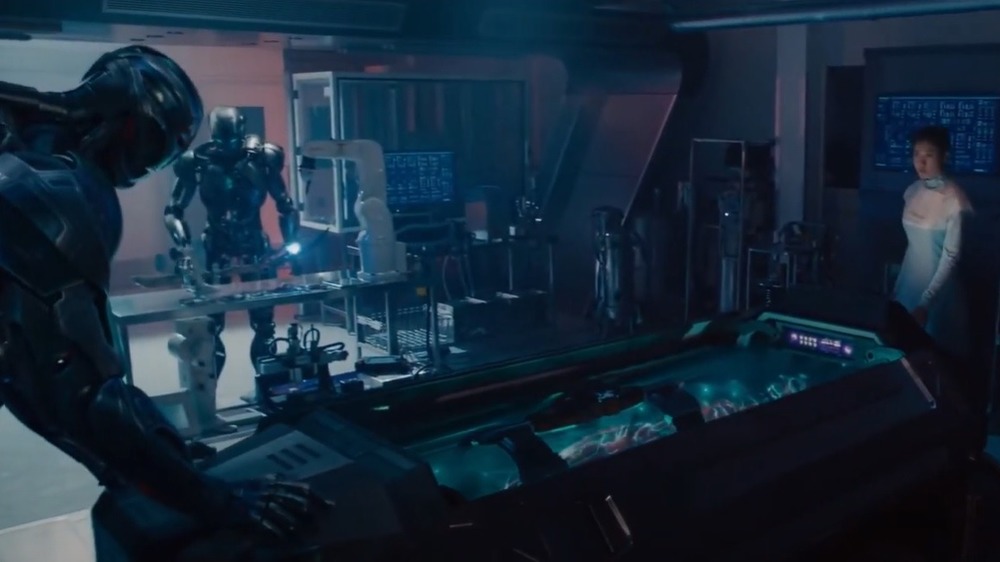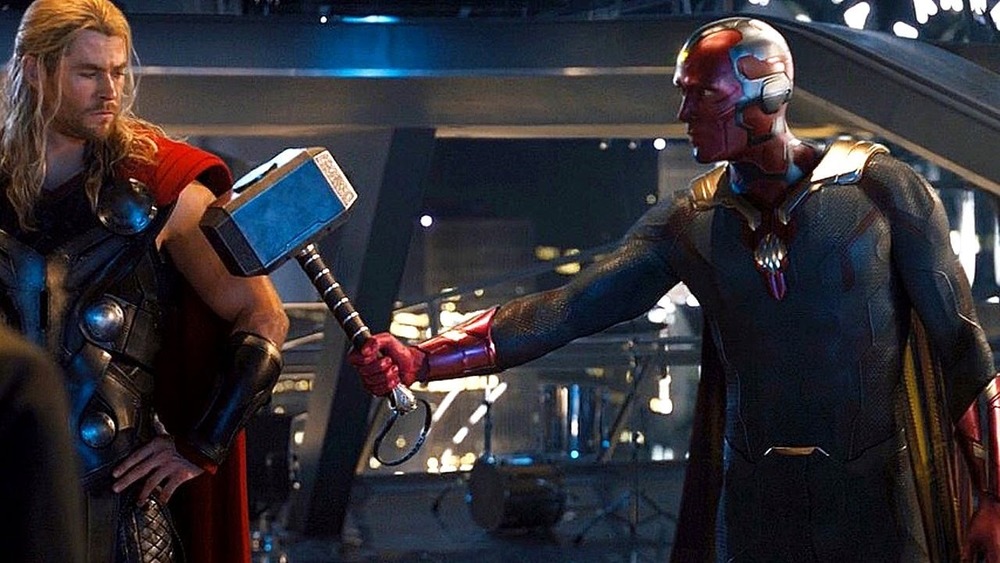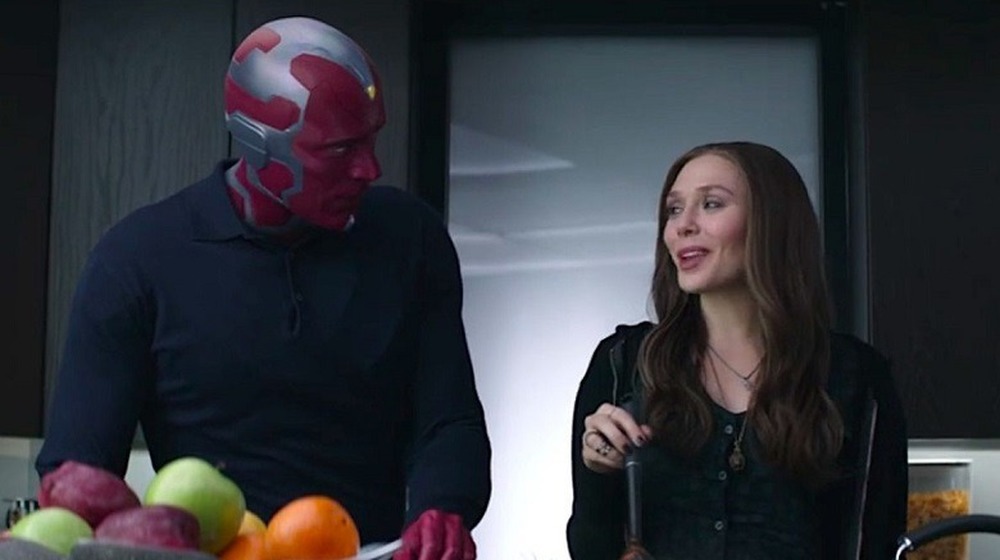Rules Vision Has To Follow In The MCU
While the origins of the Vision in the Marvel Cinematic Universe are vastly different from his convoluted origin story in the comics, the way he acts and the rules he must follow are remarkably consistent when comparing the two. The essence of the character is that he's an artificial man who feels deep emotions, making him more human than many around him. However, he's always struggling with his identity because he's made up of so many disparate elements.
One of the problems with understanding his comic book origins is that he's been retconned more than once, depending on whether or not the writer in question thought of him as being closer to a human or a toaster. That conflict was reflected in the comics themselves, where Manda Maximoff's brother, Pietro, thought the Vision was an abomination and unworthy of his sister's love. But in the MCU, both the Avengers and audiences absolutely adore Paul Bettany's take on the character. That's especially true for comic book fans who understand how this big-screen hero connects to the comics and how his actions and behaviors are all guided by the superhero source material. What do we mean exactly? Well, from his robo-parentage to his relationship with humanity, here are all the rules that Vision must follow in the MCU.
Ultron has to be his father
In the comics, Ultron created the Vision to be his servant and kill the Avengers, specifically his own "father" and creator, Dr. Henry Pym. How exactly did he achieve this? Well, Ultron took the Human Torch's lifeless body from the Mad Thinker and altered him. When Ultron first brought the Vision to life, the brain patterns of the Human Torch remained. But this isn't Johnny Storm we're talking about. Instead, this Torch was an android and hero from World War II (aka Jim Hammond) who was in a superhero team called the Invaders, along with Captain America and the Sub-Mariner. Thanks to this background, Vision immediately rebelled against his creator. However, Ultron subdued him and gave him Simon Williams' (aka Wonder Man) brain patterns and put in a number of failsafe programs that would force the Vision to help rebuild him if he were ever destroyed.
Despite Vision almost immediately turning against his master, Ultron, the killer robot with an Oedipus complex always considered the Vision to be his own son. However, in the MCU, Ultron built the Vision's body out of vibranium in order to move his own consciousness into a perfect, powerful approximation of a human body. Here, the Vision rebelled for different reasons, but Ultron always has to be involved in his origin because they're two sides of the same coin. They're both artificial consciousnesses who are deeply emotional, but the suffering they witness humanity inflict on itself drives them in different directions. For Ultron, humanity is a disease that has to be eradicated. For Vision, humanity is a mystery that has to be embraced.
In the comics and the MCU, Vision has to immediately become an Avenger
In the comics, Ultron sent the Vision to destroy the Avengers. Soon after, he was given his name by the Wasp, who nearly fainted when she saw the ghostly figure materializing through a wall, trying to kill her. However, it took all of one fight for the Vision to snap out of his programming and turn against his creator. The Avengers, always a forgiving group that admitted a number of ex-criminals, offered him a space in their ranks after he used his density-changing powers to defeat Ultron. From that point on, the Vision was one of the most steadfast Avengers for well over a dozen years, even becoming the sole figure featured in their cover corner box for a long time.
In the Marvel Cinematic Universe, Vision was created by both the Avengers and Ultron. And within minutes of his creation, he joined the team in an effort to stop Ultron from exterminating humanity. No other Avenger immediately became a member upon their introduction, and it was a role he embraced. That may have been because of the loyalty he already felt to the team because of his mental makeup or because of the way they immediately accepted him, even if he was an artificial being. Regardless, being an Avenger meant everything to Vision, which is one reason why he sided with Iron Man during Civil War. He believed that power must be contained and monitored, even if it was well-meaning.
He has to fall in love with Wanda
In the comics, the Vision was content with fighting evil and playing the occasional game of chess for the first couple of years he was an Avenger. However, when the Scarlet Witch rejoined the team after a long absence, they were slowly drawn to each other. Indeed, their simmering romance became the most important subplot in the Avengers for many years, as the two of them wondered if they could ever be together.
It was crucial for the Vision, in particular, because he was wondering for the first time just how human he actually was, as he was going through a series of trials that tested his humanity. On Wanda's part, she rebuffed ultra-macho guys like Arkon and Hawkeye, but she found herself drawn to the sensitive Vision. However, their romance later had to survive Mantis trying to make the Vision her man. The eventual affirmation of their love and marriage by way of Immortus was one of the great Marvel romances.
In the MCU, they shortened the courting period, but it was no less intense. The Vision was smitten with her, making her native dishes even as they were on opposite sides of the Civil War. Eventually, they risked everything to be together, only to have their love ripped apart by Thanos in his quest to get Vision's Infinity Stone. Is it any wonder why Wanda resurrected him in WandaVision? It was clear they belonged together.
Vision's brain patterns must come from somewhere else
How exactly the Vision's personality came to be in the comics has always been an intriguing mystery. Why? Because while he's his own man, his starting point was identical to Simon Williams' brain. Rather than clones, this made them more like twins, only the Vision's mind developed differently from his "brother's." While they had similar tastes, they had different reasons for liking jazz, for example. At the same time, there were also deep memories from the Human Torch that would occasionally rise to the surface, like his claustrophobia.
In the MCU, the Vision was even more complex. Part of him was J.A.R.V.I.S., the sophisticated AI system that Tony Stark invented. Part of him was Ultron's influence, given their battle and exchange of information early in Avengers: Age of Ultron, not to mention the fact that Ultron made his physical body. Part of him was also the influence of Tony Stark and Bruce Banner, who created Ultron and did a bit of reprogramming when it came to Vision's consciousness. Part of him was the Asgardian energy of Thor powering him up, and part of him was the Mind Stone itself. It was this mix of science, magic, and cosmic energy that created a new form of sentient life, and it's an essential part of the character that his personality should be his own, even if it came from many different sources. Even in WandaVision, the Vision rebelled against Wanda's control, despite the role she played in bringing him back to life.
He has to have red skin
The Vision's bright red skin has always made him a distinctive and unusual-looking superhero. Combine that with his distinctive yellow-and-green costume and flowing cape, and he's always popped off the page whenever he's appeared in the comic. His red skin was a nod to the fiery form of the android Human Torch of the 1940s, the body that he inherited from Ultron. It was Ultron's cruel little joke to himself that reminded him of the Vision's true form, something the Vision himself wouldn't learn until much later.
In the MCU, the Vision's uniform has a greatly muted color scheme along the lines of most of the other heroes. What works on the page in terms of color would seem garish on the big screen. Indeed, the episode of WandaVision where he wears a Halloween costume that approximates his comic book look makes that garishness clear. Instead, Vision wears mesh armor with a dark green hue, and while he still keeps the yellow cape, it's smaller and darker than the comic book version. However, the Vision's skin is one element that hasn't changed at all, and it looks even brighter on the screen because every other aspect of his appearance is otherwise muted. It effectively establishes him as unique but still makes him look much more like a human than a construct. In other words, he appears like a being of flesh and blood.
Vision has to be able to change his density in both the comics and the MCU
The Vision has always been compelling because of his distinctive outlook and striking appearance, but his powers have always been another big draw. This is one area where the MCU and the comics have been in complete agreement. Why meddle with something that's already perfect? The Vision's density-changing powers make him an extremely difficult opponent to handle. He can make his skin diamond-hard and pack a punch that rivals powerhouses like Thor and Iron Man. He can also simply turn intangible if he prefers not to fight or if he's massively outnumbered. This ability also makes him a highly effective spy and scout. He can penetrate virtually any defenses and find out what's behind them.
Deadliest of all is his disruption ability. He can simply stick his arm inside of someone and materialize it just slightly, causing incredible agony for his opponent. If he was more vicious, he'd suddenly materialize his hand and arm to make them as hard as possible in order to kill his opponent. The Vision has other powers, like his solar beams, computer interfacing, and electronics disruption. However, it's his ghostly ability that gave him his name in the first place and makes him one of the most versatile superheroes, both in the comics and the MCU.
He has to have a forehead gem
The Vision's forehead gem is another distinctive characteristic of the hero that follows him from the comics to the MCU. Long before Adam Warlock wore the Soul Gem on his forehead, the Vision's jewel in the comics served a few purposes. The Vision, in both the films and the source material, doesn't eat like human beings. Sure, in the comics, he actually can consume food and even draw a little sustenance from it, but his main source of power is solar energy drawn and collected by the gem on his forehead. The gem also allows him to concentrate his power and emit it in the form of sizzling eye blasts.
The MCU made his forehead gem a much more powerful object – the Mind Stone. In the wrong hands, the artifact could turn anyone into a completely loyal servant. But when Tony Stark and Bruce Banner studied it further, they realized that this was the least of the Mind Stone's abilities. In fact, it was capable of creating artificial intelligences. Of course, neither scientist fully understood the Stone's full capabilities, and without their guidance, the first intelligence — Ultorn — was paranoid and distrustful of a humanity that it saw as a plague on the world. But thanks to the urging of Thor, the Avengers used the Stone to create a second intelligence, and the benevolent Vision used the Stone as a power source. Granted, the Stone was Vision's undoing as Thanos plucked it from his head, but it just goes to show that whether he's on the page or the silver screen, Vision desperately needs that gem.
He has to be a synthetic man, not a robot
When the original Human Torch was created by Dr. Phineas Horton, the most remarkable thing about him was that he was, for all intents and purposes, a man made out of artificial parts. He had roughly the same functions as a human, only his organs were all man-made constructs. Of course, the Torch's initial design flaw was that he burst into flame upon contact with oxygen, which led Horton to stick him in a tube for a number of years before the Torch escaped and eventually became a force for good. Ultron tinkered with the Torch's body to create the Vision, but the essence of the character remained — he was a synthetic humanoid, also known as a synthezoid. Like the Torch, his body mimicked that of a human's, with the main differences being his powers and how he gained energy.
Similarly, in the MCU, Ultron turned to geneticist Dr. Helen Cho to use her Regeneration Cradle to create a new, perfect body. It was a 3D biological device that "printed" human cells and grafted them on wounded tissue, providing healing for the most dire of injuries. Ultron had the idea of using that machine and bonding its nanomachines to Wakandan vibranium in order to create his new body. He was then going to use the Mind Stone to upload his consciousness ... before Wanda and Pietro stole the Cradle and double-crossed him. The resulting Vision was made out of vibranium shaped into synthetic human tissue, but in short, Vision is always more than a robot, no matter the medium.
Vision has to attack the Avengers upon meeting them
It's a rite of passage for superheroes when they meet other superheroes — they have a misunderstanding that turns into an argument that leads to a fight. It happened with Thor, Iron Man, and Captain America, and it happened with the Vision, as well. In Age of Ultron, Tony Stark and Bruce Banner believed that uploading J.A.R.V.I.S. into the new body that Ultron was building would turn this unconscious synthezoid into a powerful ally. Captain America, Wanda Maximoff, and Quicksilver all thought this was a terrible idea, and they all got into a fight trying to stop it. And that's when Thor showed up and zapped the Vision's Regeneration Cradle with lightning and created something new.
Upon being "born," Vision was confused and attacked Thor. When Thor belted him across the room, Vision calmed down and immediately apologized. That was a novel approach for a superhero, who de-escalated a fight instead of making it worse out of foolish pride. Vision even changed his form to mimic Thor's a bit, including adding a cape. He also offered up a highly sensible speech — the Avengers might not trusted him, but Ultron had to be stopped, and he could help. When he effortlessly hefted Thor's hammer and tossed it to him, that definitely added a lot of weight to his argument! The briefness of his battle with the Avengers matched that in the comics, as the Vision simply couldn't stand fighting those who should be his friends.
Vision has to love and be curious about humanity
The Vision's love for and curiosity about humanity is perhaps the most important element of his character. In the comics, this can be partially explained by the Vision having the brain patterns of Simon Williams, as well as the existing structure of an android that lived as a human named Jim Hammond. He was interested in art, literature, music, and even comics. He took on a human guise and identity known as "Victor Shade" and hung out in jazz clubs. Of course, Wanda was the great love of his life, but he was interested in all humans.
In the MCU, that curiosity played out in a more gregarious and childlike way. When he was in a final showdown with Ultron, Vision said there was a "certain grace" to the failings of humanity. When Ultron called him "unbearably naive," Vision responded by saying, "Well, I was born yesterday." That dry sense of humor carried over into his interactions with the other Avengers, especially Wanda. It also surfaced in WandaVision, as the Vision's wit served him well in all of the sitcom wackiness conjured up by the Scarlet Witch.
